A robot has been developed in Singapore that can spray-paint the interiors of industrial buildings faster than humans, operating around the clock, even in complete darkness.
PictoBot is an example of how autonomous robots can be deployed to boost productivity and overcome the manpower constraints that Singapore faces in the construction industry– George Loh, National Research Foundation
Called PictoBot, the machine can paint a high interior wall 25% faster than a crew of two painters.
It was developed by a local university and the government to address safety and productivity issues, plus the manpower and resource constraints faced in the city state.
“Painting large industrial spaces is repetitive, labour intensive and time-consuming. PictoBot can paint while a supervisor focuses on operating it,” said principal investigator Prof Chen I-Ming, director of the Robotic Research Centre at Nanyang Technological University (NTU).
“The autonomous behaviour also means that a single operator can handle multiple robots and refill their paint reservoirs,” he added.
PictoBot scans the interior space with an optical camera and laser to navigate, while painting walls up to 10m high with its robotic arm.
It can work four hours on one battery charge, giving walls an even coat of paint that matches industry standards, NTU said in a press notice.
Thanks to its sensors, PictoBot can also operate in pitch black, enabling 24-hour continuous painting.
At a glance, PictoBot components are:
- A six-axis robotic arm that can move fast and steadily;
- Precision spray nozzle and high pressure paint pump that is four times faster than brushing or rolling;
- Automated jack-up platform that enables it to reach up to 10m;
- Optical camera to scan the work space to calculate trajectory of nozzle and paint;
- Laser scanner to measure the range and distance.
It took a year for NTU to develop PictoBot, working with JTC Corporation, a state-owned industrial developer, and local start-up Aitech Robotics and Automation.
“In Singapore, the demand for construction projects is expected to increase as we continue to develop. PictoBot is an example of how autonomous robots can be deployed to boost productivity and overcome the manpower constraints that Singapore faces in the construction industry,” said George Loh, programme director of the National Research Foundation.
Singapore is currently building new, compact manufacturing facilities, such as such as “JTC Space @ Gul”, and NTU said the next step is to test the robot at one of these developments to make sure the PictoBot matches or beats industry standards.
Image: PictoBot scans the interior space with an optical camera and laser to navigate, while painting walls up to 10m high with its robotic arm (NTU)
Further Reading:
Comments
Comments are closed.











This is no big deal. Back in 1985 I developed a self-learning system of 6 robots each with 6-axis arms for automatically spray painting the inside and outside of the many, many different form factors of railway tank cars for a major Canadian Railway. Last I heard it was still in use.